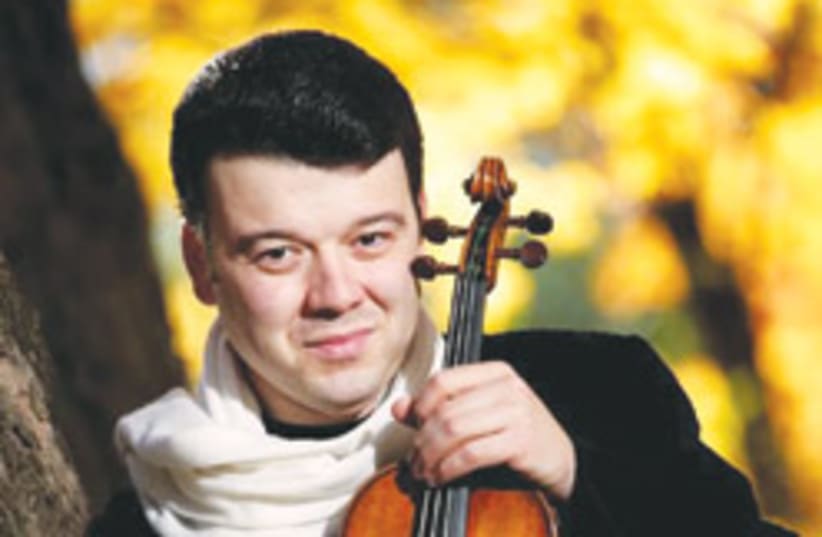His violin's in good hands
Vadim Gluzman plans a marriage-themed concert with his pianist wife.
When he was six years old, Russian-Israeli violinist Vadim Gluzman held out his hands for inspection at the Latvian school for musically gifted children. He thought they were checking for dirt under his fingernails, but after close examination, he and his hands were deemed best suited to the violin.
Today, Gluzman is one of the world's most sought-after violinists.
"The violin chose me," Gluzman says.
On July 15, Gluzman and his wife, pianist Angela Yoffe, will take a break from their busy concert schedule to perform a benefit recital in Ra'anana for the English Speaking Residents Association (ESRA). The program includes Jean-Marie Leclair's "Sonata No. 3" for violin and piano, César Franck's "Sonata for Violin and Piano in A Major," "Nigun" by Ernest Bloch, and Mario Castelnuovo-Tedesco's "Figaro," a transcription of Rossini's "Barber of Seville."
The theme of marriage unites the first half of the program.
"It's very appropriate, because my pianist is also my wife. And Leclair was apparently killed by his wife. So I should be very careful," Gluzman jokes.
"The sonata by César Franck was actually a wedding present to Eugène Ysaÿe, who was one of the greatest violinists of all time. Ysaÿe played the violin part and Franck played the piano part at Ysaÿe's wedding."
The third piece on the program, "Nigun," is part of a larger work by Bloch entitled Baal Shem: Three Pictures of Hassidic Life.
"Bloch's 'Nigun' is probably one of the greatest classical/Jewish pieces of music ever written. Bloch was known for his ability to bridge the traditional and the classical. It's one of my very favorite pieces," Gluzman says.
According to Gluzman, it was Hassidic life that set up the historical bond between Judaism and the violin, a bond to which Gluzman has always felt strongly tied. Gluzman's Jewish background also led him to emigrate from Ukraine to Israel in 1990.
"I'm Jewish. Russian people live in Russia, French people live in France. We Jews should live at home," Gluzman declares.
Gluzman pursued his career as a violinist as soon as he landed in Israel. Two weeks after arriving, he played for famed Israeli violinist Isaac Stern.
"Isaac was an enormous example figure in my life. He was a person who was never satisfied with anything, and I mean that in a very positive way. The moment you took the next step, he immediately had you think about what was the next step to take," Gluzman recalls. "Isaac is no longer with us, but I hope to continue his tradition."
Two months after immigrating to Israel, Gluzman studied at the inaugural season of Keshet Eilon, the prestigious violin master course at Kibbutz Eilon in the Western Galilee. After studying at Keshet Eilon for several years, Gluzman was invited back as a member of the faculty. He will return again this summer.
"Keshet Eilon is something that's part of my skin and blood. I can't imagine not having it in my life," he says.
The audience at the recital in Ra'anana this month will be in for a special treat: Gluzman plays on a Stradivarius violin from 1690. Named after renowned Russian-Jewish violinist and pedagogue Leopold Auer, the "ex-Leopold Auer Stradivari" has been on loan to Gluzman for the past 11 seasons from the Stradivari Society of Chicago.
"My fiddle is quite special. I'm very fortunate to have this violin. It has an incredibly wide color palette; it's infinite. It also has an incredible power projection," he says. "When I first played it, I thought someone had given me a new set of hands. I couldn't believe that it was me playing."
Gluzman and Yoffe will perform on July 15 at Hamishkan Music and Art Center at Rehov Hashomer 19 in Ra'anana. There will be a reception at 7:45 p.m., followed by the concert at 8:30 p.m. For reservations, call (09) 748-2957. All proceeds go to ESRA community projects.
if(catID != 151){
var cont = `Take Israel home with the new
Jerusalem Post Store
Shop now >>
`;
document.getElementById("linkPremium").innerHTML = cont;
var divWithLink = document.getElementById("premium-link");
if(divWithLink !== null && divWithLink !== 'undefined')
{
divWithLink.style.border = "solid 1px #cb0f3e";
divWithLink.style.textAlign = "center";
divWithLink.style.marginBottom = "40px";
divWithLink.style.marginTop = "40px";
divWithLink.style.width = "728px";
divWithLink.style.backgroundColor = "#3c4860";
divWithLink.style.color = "#ffffff";
}
}
(function (v, i){
});

